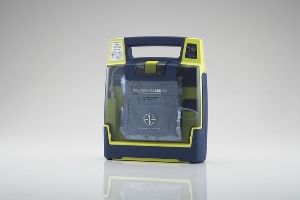Sudden cardiac arrest (SCA) is the leading cause of sudden death in exercising young athletes, but despite data showing that early defibrillation with automated external defibrillators (AEDs) can save nearly two-thirds of student-athletes who suffer SCA, many U.S. high schools are not prepared to respond to an SCA or have significant deficiencies that could be improved, a new study finds. (1)

Researchers from the University of Washington, Seattle, sought to determine if having an automatic external defibrillator (AED) on a high school campus predicted the school's comprehensive emergency preparedness for SCA and to compare the demographics of high schools with and without AEDs.
What they found was that U.S. high schools with AED programs are more likely to ensure access to early defibrillation, establish Emergency Action Plans, consult local emergency medical services, review and regularly rehearse the emergency action plan, and implement a communication system to activate emergency services, but that, even in those schools, there were deficiencies in emergency preparedness:
Demographics
- 86.0% of schools with an enrollment greater than 500 had at least 1 AED compared with 76.8% of smaller schools;
- An AED was present in 81.1% of rural schools, 87.5% of suburban schools, 79.7% of urban schools, and 77.3% of inner-city schools, with suburban schools more likely to have an AED than were rural, urban, and inner schools.
- 83.2% of public schools had at least 1 AED compared with 79.6 of private schools.
Funding
- The majority of schools (51.8%) obtained AEDs through donations or grants;
- The median cost was $1,251 to $1,500;
- The median yearly maintenance cost was less than $250;
- For schools without AEDs, 38.4% had not addressed the need for an AEDs
- The primary obstacle to obtaining AEDs in schools without them was financial resources (80.7%), followed by medical-legal concerns (27.9%), uncertainty of where to place the AED (14.2%), and school policy (12.7%).
AED location, intergration, and training
- The most common locations for placing an AED were the basketball facility (41.3%), athletic training room (37.0%), nurse's office (32.2%), classroom building (27.8%) and football facility (18.7%)
- A total of 51.7% of schools integrated their AEDs with EMS so that an EMS dispatcher was aware of the location of the AED.
- The school staff most commonly trained in AED use were coaches (74.3%), school nurses (72.2%), athletic trainers (65.5%), administrators (63.8%), and teachers (46.6%).
- The school nurse was the person responsible for AED maintenance in 56.7% of schools with AEDs.
Emergency preparedness
- Access to early defibrillation: 84.6% of schools with AEDs reported having access to early defibrillation at every sporting venue (defined as less than 3-5 minutes from time of collapse), compared to 24.5% of schools without AEDs.
- Emergency action plan: most schools with AEDs (86.5%) had established an EAP, compared with only 47.4% of schools without AEDs. Of the schools with an EAP, 67.8% of schools with AEDs developed the EAP in consultation with local EMS, compared to 57.6% of schools without AEDs. Of the schools with AEDs and EAPs, 40,9% regularly practiced or rehearsed the plan compared with only 12.7% of schools without AEDs.
- Communication system: A total of 90.3% of schools with AEDs and 86.6% of schools without AEDs had established communication systems to activate EMS.
- Training in CPR: 79.8% of schools with AEDs and 78.1% of schools without AEDs trained coaches in CPR.
Many high schools unprepared
"This study illustrates that many high schools are not prepared to respond to an SCA or have significant deficiencies that could be improved," said lead author, Brett G. Toresdahl, MD, of the Department of Family Medicine at the University of Washington, Seattle. "Roughly 1 in 5 schools did not have an AED, half of schools without AEDs did not have any EAP for SCA, less than half of schools with an EAP regularly reviewed and rehearsed the plan, and 1 in 5 high schools did not train their coaches in CPR," he said.
Because the study was not designed to measure the true prevalence of AEDs in high schools, and responder bias likely explained the high proportion of participating schools with AEDs, the results "may represent a best-case scenario and overrepresent actual emergency preparedness in high schools throughout the country," Toresdahl wrote. "Nonetheless, the presence of AEDs in high schools is clearly associated with better overall emergency preparedness for SCA. ... Significant potential remains for nationwide improvement in preparedness for SCA in US high schools."
1. Toreshdahl B, Harmon K, Drezner J. High School Automated External Defibrillator Programs as Markers of Emergency Preparedness for Sudden Cardiac Arrest. J Athl Train 2013;48(2):242-247.
Posted May 5, 2013








